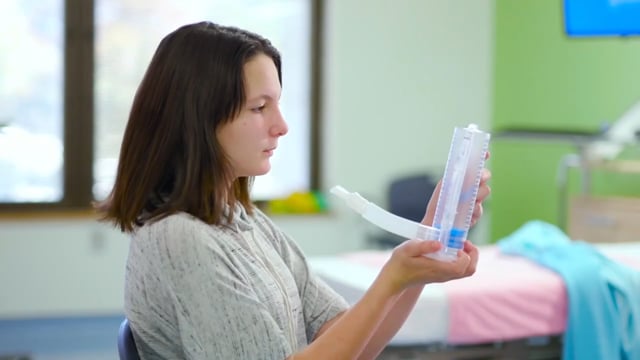What Is an Incentive Spirometer?
An incentive spirometer (pronounced: spy-ROM-eh-tur) is a hand-held device that helps people to take slow, deep breaths. It's like exercise equipment for the lungs to keep them strong and working well.
Why Do People Need an Incentive Spirometer?
Breathing deeply helps get enough air into the lungs so they inflate as much as possible. Breathing slowly helps inflate all areas of the lungs, not just part of them.
When people don't breathe deeply enough, fluid and germs can build up in the lungs. This can lead to infections like pneumonia. Using an incentive spirometer can help stop this from happening.
Doing incentive spirometry doesn't just help people who are healing from surgery. It also helps some people with conditions like cystic fibrosis that affect the lungs.
How Does an Incentive Spirometer Work?
An incentive spirometer is made of hollow, clear plastic. It has a tube with a mouthpiece attached.

The main part of the spirometer shows how deeply you breathe in. There is a big grid with lines and numbers on the spirometer. As you breathe in, a piston moves up the lines. (The piston is the large blue disc in the main part of the spirometer, pictured above.) The more air you breathe into your lungs, the higher the piston goes. Your care team will move a slider on the main grid to set a goal for how deeply you should breathe.
A range indicator on the side of the spirometer shows how slowly you breathe in. Next to the main part of the spirometer, there's a second area with arrows or lines showing a range. As you breathe in, a ball (or other indicator) goes up and down. If you breathe in too fast, it shoots to the top. You need to breathe in slowly — but not too slowly — to keep the indicator in the target range.
At first, it can be hard to reach your goal. That's normal. Incentive spirometry is like any workout: The more you do it, the easier it is to get to your goal.
How Often Do People Do Incentive Spirometry?
How often you need to use the spirometer depends on the reason for doing it.
After Surgery
The spirometer helps you get better after surgery, but you will probably practice it at home first. This lets you get used to using it and learn what it feels like to do it right. After surgery, you will need to use the spirometer about 10 times each hour when you're awake.
For a Lung Illness
People with cystic fibrosis might need to use the spirometer when they do other types of breathing treatments. People with sickle cell disease might use the spirometer at home or if they're in the hospital with lung problems or pain.
Your care team will let you know the schedule that's best for you.
What Else Can I Do?
Using the spirometer can be a challenge. After all, when people are recovering from surgery, most of the time they just want to rest. But exercising the lungs through incentive spirometry could help you get home faster. Lung infections or other problems will hold back your recovery and keep you in the hospital longer.
These tips can keep you on track:
- Set a goal. Make a plan for how you will fit the required number of breathing exercises into your daily routine. For example, aim to do 10 breaths during each commercial break while you watch TV.
- Set a reminder. Program your phone to remind you when it's time to do your breathing exercises. There's something about that reminder bell that can spur us into action (and it's better than feeling like a parent is nagging you!).
-

How to Use an Incentive Spirometer


